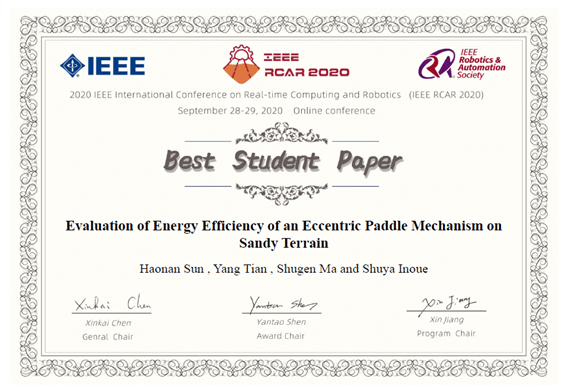Hello everyone, I’m Yiming Cao, a doctor student (D4) in MaLab.
I am one of the onsite participants in the 2022 IEEE/RSJ International Conference on Intelligent Robots and Systems (IROS 2022), which has been held in Kyoto, Japan from October 23-27, 2022.
The theme of the conference is “Embodied AI for a Symbiotic Society”. Over 3,800 onsite participants and 873 online participants attended the conference.
As an onsite presenter, I presented my research content at the conference. Personally, it was my first onsite academic presentation. I am pleased that I had the opportunity to communicate with many outstanding researchers face-to-face.
I have given a presentation on the following topic:
Yiming Cao, Longchuan Li, and Shugen Ma, A Creeping Snake-like Robot with Partial Actuation.
During the meeting, I received some constructive and valuable comments from other researchers, which will provide important references for my future research.
What I have learned from the experiences are:
(i)Introduce my research as telling a short story. Basically, the story should cover the motivation (why?), goal (what?), methods (how?), and results (so what?). Thus, while doing the research, I should think of the presentation as a big picture that hooks the viewer, to help people easily understand my work. Meanwhile, keep the story engaging, logical, and accessible.
(ii)Refine the main points while answering a question. Due to the time limitation, I should know how to answer attendee questions concisely and directly.

Presenter・Fourth year Docter’s course Yiming Cao
Yiming Cao, Longchuan Li, Shugen Ma, A Creeping Snake-Like Robot with Partial Actuation, in Proc. 2022 IEEE/RSJ International Conference on Intelligent Robots and Systems (IROS 2022), pp. 1202-1207, 2022, Kyoto, Japan.

Presenter・First year Master’s course Chihiro Hirose
Atsushi Kakogawa, Chihiro Hirose, Shugen Ma, A Standards-Based Pipeline Route Drawing System Using a Towed Sensing Unit, in Proc. 2022 IEEE/RSJ International Conference on Intelligent Robots and Systems (IROS 2022), pp. 7167-7173, 2022, Kyoto, Japan.

Presenter・First year Master’s course Kenya Murata
Atsushi Kakogawa, Kenya Murata, Shugen Ma, Vertical Bend and T-branch Travels of an Articulated Wheeled In-pipe Inspection Robot by Combining Its Joint Angle and Torque Controls, in Proc. 2022 IEEE/RSJ International Conference on Intelligent Robots and Systems (IROS 2022), pp. 13254-13259, 2022, Kyoto, Japan.
I am one of the volunteers of IROS 2022.
Due to COVID-19, most of the sessions were hybrid. My partner Mr. Ma Zhenxuan (M1) and I were the staffs in charge of Room 7 (Room E) of the conference. The specific work of us was to ensure that both onsite and online presenters could successfully present their research and discuss with each other.
What I have learned from the experiences are:
- When encountering a problem, BE POSITIVE. That means taking problem-solving as a priority and being sedated to deal with problems.
- Combine past failure experiences and use divergent thinking to consider problems that we might encounter in advance. The goal is to break big tasks down into details.

I am the MC of the conference event at IROS 2022. My task is to keep an event moving and to introduce contributed chairs to the audience. Thanks to the trust of our Prof. Shugen Ma, I have learned many important abilities to be an MC, such as how to capture and maintain the attention of the guests, and skillfully deal with emergent phenomena.

During the conference, we enjoyed the performance of Wadaiko, which is known as the heartbeat of Japan, as well as the amazing Japanese fireworks, Hanabi.
It’s my great honor to participate in IROS 2022, thanks to Prof. Ma, Prof. Tian, Prof. Li, Prof. Kakogawa, and the kind members in MaLab. I learned a lot from the conference, not only for my research but also for my whole life experience. I’ll keep them in mind and do my best in my future life.








































